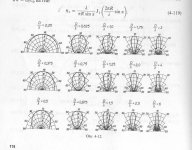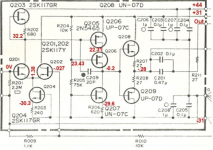Sure, presumably no one wants that dirty break up sound and I also dislike directivity effects, but Ed is making another point here that explains quite well what I hear in the upper band of well designed drivers ( but before break up ) - both tweeters & bass / mids.
They can sound quite pleasant but seem to lack grip.
I don't mind this so much in tweeters but I don't like it in the mid band.
They can sound quite pleasant but seem to lack grip.
I don't mind this so much in tweeters but I don't like it in the mid band.
Last edited:
I'm saying that desiging a conventional symmetric Linkwitz-Riley XO generally gives the best compromise for the drivers overall (this is agreed on by many people), its only drawback is the allpass behaviour making it non transient-perfect, and that can be eliminated by preprocessing the input signal with an analytically derived FIR -- "non-causal" -- filter (no artifact), giving a linear phase Linkwitz-Riley XO. The filter kernel for convolution is simply the time inverse of the allpass impulse response. This is probably one of the few things where a free lunch can actually be had, the main downside are latencies of the filter itself and of the digital processing and a slight loss of headroom / dynamic range. Typically one has to lower input level to the convolver by 6dB or so to avoid digital clipping.😎🙂I did, just recently again, true realtime A/B, symmetric slope even order zero interphase allpass XO (Linkwitz-Riley and phase-matched Bessel) with signal phase predistortion to cancel the allpass always did much better than any analog TP, for obvious reasons (at least to me). Zero interphase is the key -- no lobing errors --, analog TP cannot do that (a mathematical constraint) except for D'Appolito-style arrangement.
maybe you can show more about this -somewhere?
Thx-RNMarsh
A tool to play with, for these matters, is rePhase (freeware, there's a thread on it here at DIYA).
For a real world example, look up the white paper on the Grimm Audio LS1 monitor speaker, albeit IIR filters are used for the driver EQs and XO instead of analog ones (but they behave the same), and ahead of that is a small FIR filter that undoes the allpass phase.
Yes, always directivity, but the reason I ask is because I'm pretty sure the dispersion patterns will be different with different shaped "perfect pistons" and I would be interested to understand this more.
for example, for me there is something about the sound of a whizzer cone that is truly appalling and I'm pretty sure it's connected with the steep sided cones they use for these. Other distortions may be there also but I'm talking of that focusing effect of the whizzer cones.
p.s. I know some people love the sound of a full range speaker with a whizzer cone - even the treble ! - I accept that, but I don't understand it 🙂
for example, for me there is something about the sound of a whizzer cone that is truly appalling and I'm pretty sure it's connected with the steep sided cones they use for these. Other distortions may be there also but I'm talking of that focusing effect of the whizzer cones.
p.s. I know some people love the sound of a full range speaker with a whizzer cone - even the treble ! - I accept that, but I don't understand it 🙂
Last edited:
To play with ideal (rigid) pistons, the AxiDriver simulator by "R&D Team" provides some detailed insight. Demo version will do.
I think this is what Ed's point is all about :
http://www.xlrtechs.com/dbkeele.com/PDF/Keele (2003-10 AES Preprint) - Nom vs True Eff High BL.pdf
www.extra.research.philips.com/hera/people/aarts/RMA_papers/aar03c4.pdf
Use the strongest motor you can get, EQ the response at will, use PWM amps because of the high voltage requirements and very reactive nature of the load, and it won't get any better than this.... well, optimize amp output impedance profile for the best large signal behaviour as such drivers have a strong local feedback (input voltage controls cone velocity).
http://www.xlrtechs.com/dbkeele.com/PDF/Keele (2003-10 AES Preprint) - Nom vs True Eff High BL.pdf
www.extra.research.philips.com/hera/people/aarts/RMA_papers/aar03c4.pdf
Use the strongest motor you can get, EQ the response at will, use PWM amps because of the high voltage requirements and very reactive nature of the load, and it won't get any better than this.... well, optimize amp output impedance profile for the best large signal behaviour as such drivers have a strong local feedback (input voltage controls cone velocity).
I think this is what Ed's point is all about :
http://www.xlrtechs.com/dbkeele.com/PDF/Keele (2003-10 AES Preprint) - Nom vs True Eff High BL.pdf
www.extra.research.philips.com/hera/people/aarts/RMA_papers/aar03c4.pdf
Use the strongest motor you can get, EQ the response at will, use PWM amps because of the high voltage requirements and very reactive nature of the load, and it won't get any better than this.... well, optimize amp output impedance profile for the best large signal behaviour as such drivers have a strong local feedback (input voltage controls cone velocity).
So it's well covered in the literature, why were folks surprised? I don't get it. I've seen huge rigid panels driven with pneumatic actuators used as base transducers.
To play with ideal (rigid) pistons, the AxiDriver simulator by "R&D Team" provides some detailed insight. Demo version will do.
Hi KSTR
thx for the links
Please stop what? PMA. Asking questions? I tend to agree that this crowd, (including me) are not aggressive enough to WANT to answer questions, but want to be told the answers.
http://www.klippel.de/uploads/media/KLIPPEL_Sound_Radiation_Poster_01.pdf
http://www.klippel.de/uploads/media/KLIPPEL_Cone_Vibration_Poster_01.pdf
https://www.google.gr/url?sa=t&rct=j&q=&esrc=s&source=web&cd=4&cad=rja&ved=0CFAQFjAD&url=http%3A%2F%2Frepository.tudelft.nl%2Fassets%2Fuuid%3Ab3d96462-a45a-4aa7-b867-ff34e63f790d%2FP_1804_5211.PDF&ei=Z3FnUqLmLMKx0AXezoCICw&usg=AFQjCNHhRtMB7ptfenD_rLe3vfI15-gltA
George
Yes, always directivity, but the reason I ask is because I'm pretty sure the dispersion patterns will be different with different shaped "perfect pistons" and I would be interested to understand this more.
for example, for me there is something about the sound of a whizzer cone that is truly appalling and I'm pretty sure it's connected with the steep sided cones they use for these. Other distortions may be there also but I'm talking of that focusing effect of the whizzer cones.
p.s. I know some people love the sound of a full range speaker with a whizzer cone - even the treble ! - I accept that, but I don't understand it 🙂
Different shape cones/domes show very little difference in dispersion pattern; key is circumpherence (or diameter).
The problems with whizzer cones are too numerous to mention and not worth the mental exercise of sorting them out.
I guess on a high end thread we have to reference high end whizzer cones
Feastrex NF-9 Drivers Pair, Ultimate Full Range Speakers items in Audio Feast store on eBay!
not the same I think as the co-axial speakers you had in mind
Feastrex NF-9 Drivers Pair, Ultimate Full Range Speakers items in Audio Feast store on eBay!
not the same I think as the co-axial speakers you had in mind
Last edited:
- Status
- Not open for further replies.
- Home
- Member Areas
- The Lounge
- John Curl's Blowtorch preamplifier part II

